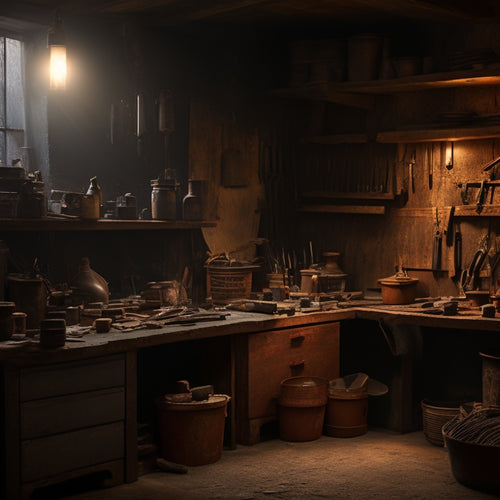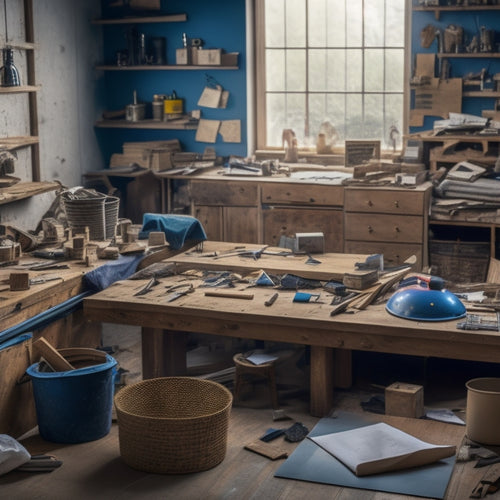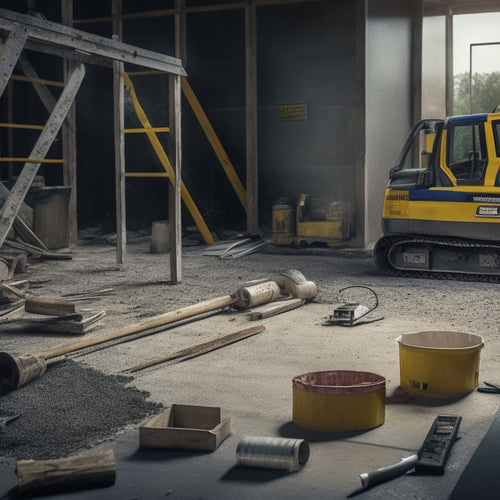
Trowel Buying Checklist for Home Renovation Success
Share
When buying a trowel for your home renovation project, you'll want to determine your specific needs by identifying the tasks that require a trowel and the desired finish. Consider the project's scale and choose a trowel material that fits, such as stainless steel for heavy-duty use or aluminum for lightweight maneuverability. Think about the ideal trowel size and shape, as well as ergonomic features like contoured handles and cushioned grips. Finally, evaluate the handle quality, considering factors like durability and balance. By checking these boxes, you'll be well on your way to selecting the perfect trowel for a successful renovation, and there's more to explore to guarantee your project's triumph.
Key Takeaways
• Identify specific trowel tasks and project requirements to ensure the right tool for the job.
• Choose a trowel material that suits your needs, considering durability, weight, and maintenance.
• Select a trowel size and shape that fits your project's scale and desired finish.
• Look for ergonomic features such as contoured handles, cushioned grips, and balanced design for comfort and control.
• Evaluate the handle quality, considering material, grip comfort, durability, and balance for optimal performance.
Determine Your Trowel Needs
As you commence your home renovation project, you'll need to identify the specific tasks that require a trowel to guarantee you're selecting the right tool for the job. This involves understanding the various trowel types and their applications.
Are you working with plaster, drywall, or concrete? Different tasks demand distinct trowel designs and features. For instance, a pointing trowel is ideal for filling small gaps and joints, while a finishing trowel is better suited for smoothing and leveling surfaces.
You'll also need to evaluate the scale of your project. Will you be working on a large, open area or confined spaces? This will influence your choice between a larger, heavier trowel or a smaller, more agile one.
Additionally, think about the type of finish you're aiming for. Do you need a trowel with a curved or straight edge? By understanding your specific trowel needs, you'll be able to choose the perfect tool for the task, ensuring a professional-looking finish and avoiding costly mistakes.
Choose the Right Trowel Material
You'll find that trowel materials vary greatly, and selecting the right one is crucial to achieving a successful outcome. Therefore, it's important to weigh the pros and cons of each option carefully.
Stainless steel trowels, for instance, offer exceptional trowel durability and resistance to corrosion, making them ideal for heavy-duty use and harsh environments. However, they can be heavy and may cause fatigue during extended use.
On the other hand, aluminum trowels are lightweight and easy to maneuver, but they may not be as durable as their stainless steel counterparts.
When it comes to trowel maintenance, you'll want to evaluate materials that are easy to clean and resistant to rust, such as stainless steel or fiberglass-reinforced nylon. Carbon steel trowels, while affordable, may require more frequent maintenance to prevent rust.
Ultimately, the right material for you will depend on your specific needs and preferences. By evaluating factors like trowel durability and trowel maintenance, you can make an informed decision that guarantees a successful renovation project.
Consider Trowel Size and Shape
Selecting the right trowel size and shape is essential, as it directly impacts the efficiency and quality of your renovation project. You'll want a trowel that fits comfortably in your hand and allows you to achieve the desired results for your specific trowel applications.
When considering size, think about the scope of your project. Larger trowels are better suited for big, open areas, while smaller ones are ideal for tighter spaces and more intricate work. Shape is also essential, as it affects the trowel's maneuverability and ability to reach into corners and crevices.
Here are some key considerations for trowel size and shape:
-
Trowel length: Longer trowels provide more leverage, but can be unwieldy in tight spaces.
-
Trowel width: Wider trowels cover more surface area, but may struggle in narrow areas.
-
Blade shape: Curved blades are great for scooping and applying material, while flat blades are better for smoothing and finishing.
- Edge type: Rigid edges provide more control, while flexible edges adapt to irregular surfaces.
Check for Ergonomic Features
When choosing a trowel, don't overlook the importance of ergonomic features that can greatly reduce fatigue and discomfort during extended periods of use. A well-designed trowel can make a significant difference in your overall user experience. As you shop for the perfect trowel, look for features that prioritize user comfort and reduce strain on your hands and wrists.
Here are some key ergonomic features to evaluate:
| Feature | Description | Benefits |
|---|---|---|
| Contoured Handle | Curved or angled handle that fits comfortably in your hand | Reduces fatigue and strain on hands and wrists |
| Cushioned Grip | Soft, padded grip that absorbs shock and vibration | Provides added comfort and control |
| Balanced Design | Evenly weighted trowel that reduces strain on your arm and shoulder | Improves overall usability and reduces fatigue |
| Angled Blade | Blade angled to reduce wrist strain and improve scooping efficiency | Enhances user comfort and productivity |
| Adjustable Handle | Handle that can be adjusted to fit your hand size and grip style | Provides a customized fit for ideal comfort and control |
Evaluate Trowel Handle Quality
As you assess the ergonomic features of a trowel, the quality of the handle itself is equally important to evaluate, as it can significantly impact the overall performance and durability of the tool. A high-quality handle can guarantee a comfortable grip, reduce fatigue, and provide the necessary leverage to get the job done efficiently.
When evaluating the handle, consider the following key factors:
-
Material: Look for handles made from durable, high-quality materials like fiberglass, aluminum, or wood that can withstand the rigors of heavy use.
-
Grip comfort: Opt for handles with contoured grips that fit comfortably in your hand, reducing slippage and strain.
-
Handle durability: Assess the handle's ability to withstand harsh environmental conditions, such as extreme temperatures, moisture, and chemicals.
- Balance and weight distribution: Verify the handle is well-balanced, allowing for smooth, even movements and reducing fatigue.
Frequently Asked Questions
Can I Use a Trowel for Both Drywall and Concrete Applications?
You're wondering if you can use a trowel for both drywall and concrete applications? Well, it's not recommended. Different trowel types are designed for specific tasks, and using the wrong one can lead to subpar results.
For drywall, you'll need a trowel with a flexible blade and a curved edge for smooth finishes.
For concrete, a stiffer blade with a straight edge is necessary for rugged, textured surfaces.
Mastering application techniques for each material requires the right tool, so don't compromise – invest in separate trowels for each job.
How Do I Properly Clean and Maintain My Trowel?
You'll want to master trowel cleaning techniques to extend its lifespan.
After each use, scrape off excess material with a putty knife. Then, wash your trowel with mild soap and warm water, and dry it thoroughly.
For tougher grime, soak it in a solution of equal parts water and white vinegar.
Regularly apply a rust inhibitor to protect the metal.
Follow these trowel maintenance tips to keep your tool in top condition and guarantee a smooth finish on your renovation projects.
Are Trowels With Rust-Resistant Coatings Worth the Extra Cost?
Will you really get your money's worth from a rust-resistant coated trowel? You're about to find out.
Let's face it, a trowel's durability is essential, and rust prevention is key. With a rust-resistant coating, you'll enjoy extended tool life and reduced maintenance.
It's a worthwhile investment if you're a frequent user or work in harsh environments. Weigh the extra cost against the benefits, and you'll likely conclude that it's a smart move for your next trowel purchase.
Can I Use a Trowel With a Worn-Out Handle or Should I Replace It?
You're wondering if you can get away with using a trowel with a worn-out handle or if it's time to replace it.
Here's the deal: a worn handle can throw off your trowel ergonomics, leading to fatigue and poor performance.
If the handle is cracked, splintered, or simply uncomfortable, it's time for handle replacement.
Don't risk compromising your work or your safety – invest in a new trowel with a comfortable, durable handle that'll help you achieve professional-level results.
Do Trowel Manufacturers Offer Warranties or Guarantees for Their Products?
As you initiate your renovation journey, you'll want a trowel that's built to last.
Do manufacturers offer warranties or guarantees for their products? The answer is yes!
Reputable brands stand behind their trowel durability, providing warranty coverage that gives you peace of mind.
Look for manufacturers that offer extensive warranties, typically ranging from 1-5 years, which cover defects, materials, and workmanship.
This guarantees your investment is protected, and you can focus on transforming your space with confidence.
Conclusion
You've made it to the final stage of trowel buying mastery!
With your newly acquired knowledge, you're now equipped to conquer the world of home renovation - or at least, your bathroom remodel.
Think of your trowel as a trusted sidekick, helping you slay the concrete jungle of spackling, plastering, and more.
With the right trowel by your side, you'll be unstoppable, leaving a trail of smooth, flawless surfaces in your wake.
Related Posts
-

Why Invest in Quality Plastering Tools for Renovation
When renovating, investing in quality plastering tools is essential for achieving professional-looking results and mi...
-

7 Best Home Renovation Project Checklists With Timelines
You're about to initiate a home renovation project, and establishing a clear plan with timelines is vital to staying ...
-

Home Renovation Safety Checklist for Homeowners
As a homeowner initiating a renovation project, you know that safety should be your top priority. Start by establishi...


